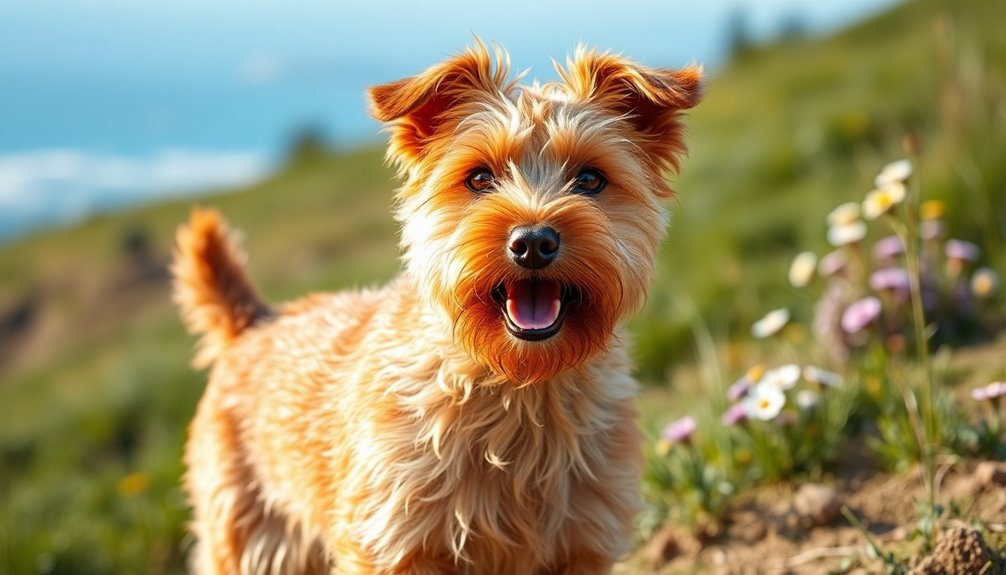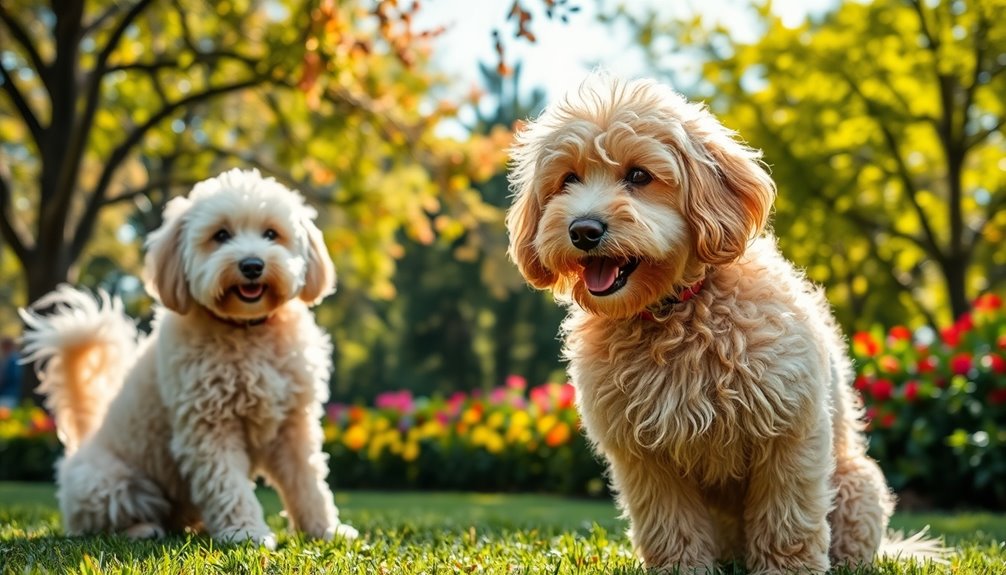Border Terriers are the ultimate spirited companions that bring joy and energy into your life. Standing at 10-11 inches tall and weighing around 11.5-15.5 pounds, their wiry double coat is not only hypoallergenic but also weather-resistant. Known for their playful, intelligent demeanor, they thrive on family interaction and love to engage with their humans. Regular exercise—about an hour daily—is essential for their health, along with quality nutrition and socialization. With a lifespan of 12-15 years, you'll forge a strong bond. Explore more about their training needs and ideal living environment to ensure a happy life together.
Key Takeaways
- Border Terriers are playful and affectionate, thriving on family interaction and known for their energetic spirit.
- They require at least one hour of daily exercise, enjoying activities like running, fetching, and dog sports.
- Regular grooming is essential, including hand stripping every 6-8 weeks and weekly brushing to maintain their double coat.
- Common health concerns include hip dysplasia and progressive retinal atrophy; routine veterinary check-ups are vital for preventive care.
- Early socialization enhances compatibility with other pets, making gradual introductions essential for healthy relationships.
Introduction
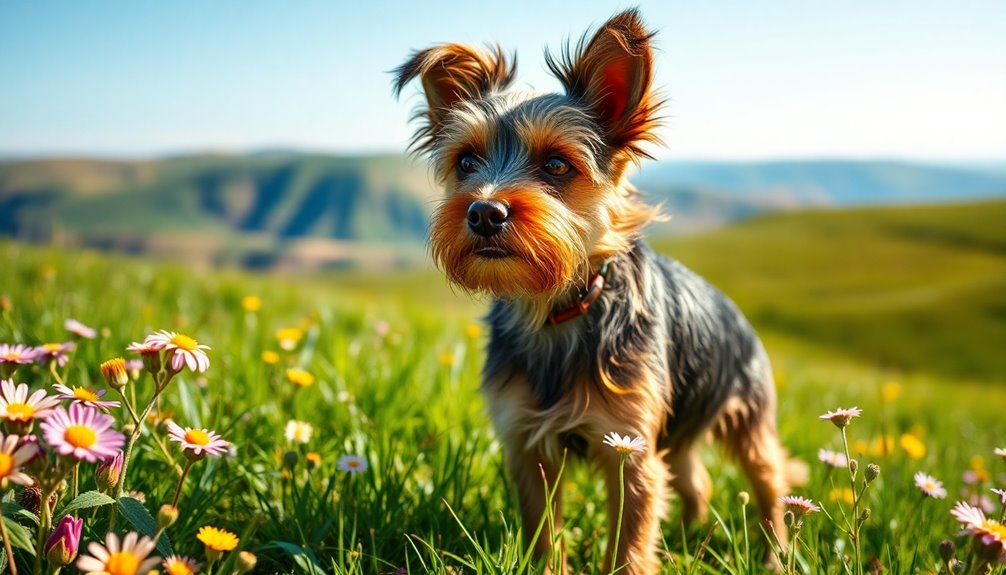
Border Terriers are delightful companions known for their spirited nature and affectionate demeanor. These small dogs typically stand between 10 to 11 inches at the shoulder and weigh around 11.5 to 15.5 pounds, making them a manageable size for various living situations.
Their short, dense, wiry double coat isn't only weather-resistant but also hypoallergenic, which is a bonus for allergy sufferers. You'll find them in colors like blue and tan, grizzle and tan, red, or wheaten, with a darker muzzle that adds to their charm.
In terms of temperament, Border Terriers are playful, intelligent, and friendly. They thrive on interaction with their families and require regular exercise to keep them happy and healthy. While they can be stubborn, early training is key to harnessing their intelligence. Additionally, they are known for their strong prey drive, which stems from their history as hunting dogs.
Keep in mind that they've a knack for escaping, driven by their energetic nature and hunting instincts.
With a lifespan of 12 to 15 years and routine veterinary care, these dogs are generally healthy. They do need regular grooming, but their maintenance isn't too demanding, making them a rewarding addition to any family.
History and Origin
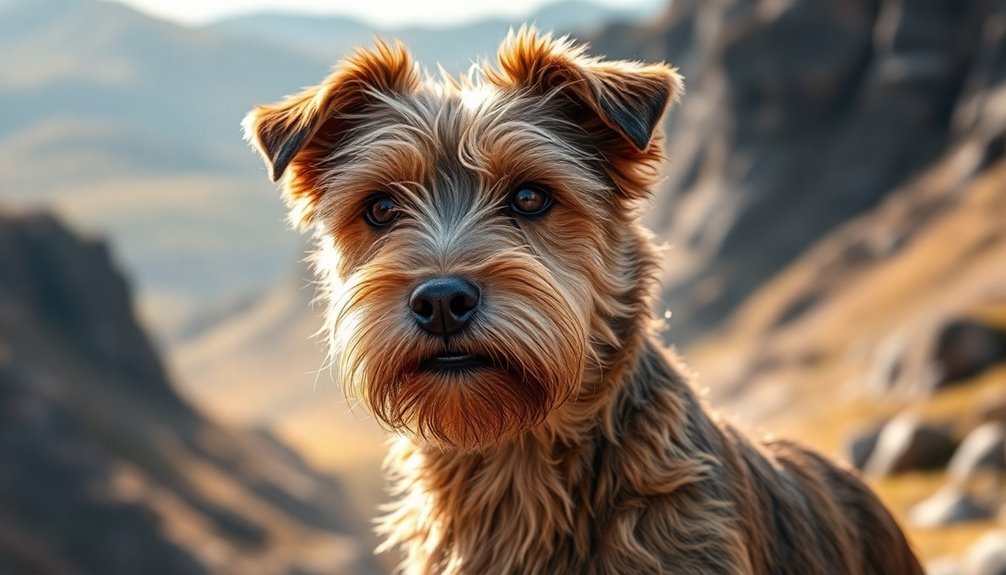
Border Terriers originated in the borderlands between England and Scotland in the early 18th century.
Bred primarily for fox hunting and pest control, they were essential for managing vermin on farms.
Their strong hunting instincts made them adept at chasing foxes into their dens and controlling other pests.
These dogs were also known for their diligent work ethic, which made them excellent companions for hunters.
Where and when the breed originated
In the rugged borderlands between England and Scotland, the Border Terrier was developed in the early 18th century. This lively breed emerged in Northumberland, specifically along the border, where local farmers and hunters sought a small, versatile dog.
The name 'Border Terrier' reflects its geographic origins, encompassing regions like Coquetdale and Redesdale. Originally, it was known as the Coquetdale Terrier or Redesdale Terrier, tracing its ancestry back to various terriers in the area.
The breed was selectively bred for its working abilities and physical traits, thriving in the demanding environment of the borderlands. While records from this period are sparse due to the breed's working nature, by the late 1800s, it was commonly recognized as the Border Terrier. Additionally, these dogs were developed for hunting vermin such as badger and fox, showcasing their versatility and tenacity.
The breed gained official recognition from the Kennel Club in 1920, coinciding with the establishment of the Border Terrier Club. It also received acknowledgment from the American Kennel Club in 1930.
Though recognized, the Border Terrier remains relatively uncommon in some regions, but its spirited personality and rich history continue to capture the hearts of dog lovers today.
Fox Hunting and Pest Control
Developed primarily for the sport of fox hunting, the Border Terrier's keen instincts and physical attributes made it an invaluable asset on the hunt. Bred to chase foxes and other small game along the borders of England and Scotland, these spirited companions were skilled at 'bolting' foxes from underground burrows.
They worked alongside hounds, cornering prey to drive it back to the surface, all while keeping pace with horses and hounds during hunts.
With their compact size, agility, and determination, Border Terriers excelled at entering tight burrows and flushing out prey. Their longer legs allowed them to cover great distances, while their large teeth and flexible spines aided in hunting tasks. Additionally, their intelligence and stamina have made them highly adaptable to various tasks beyond hunting.
Known for their distinctive bark, they helped hunters locate both themselves and their quarry underground.
Today, Border Terriers retain their strong hunting instincts, making them effective for pest control. They're often used to flush out burrowing pests like rats and rabbits, participating in earthdog activities that simulate hunting.
Their fearless nature reflects their plucky spirit, making them a humane alternative for pest control when ethical considerations and proper training are prioritized.
Physical Characteristics
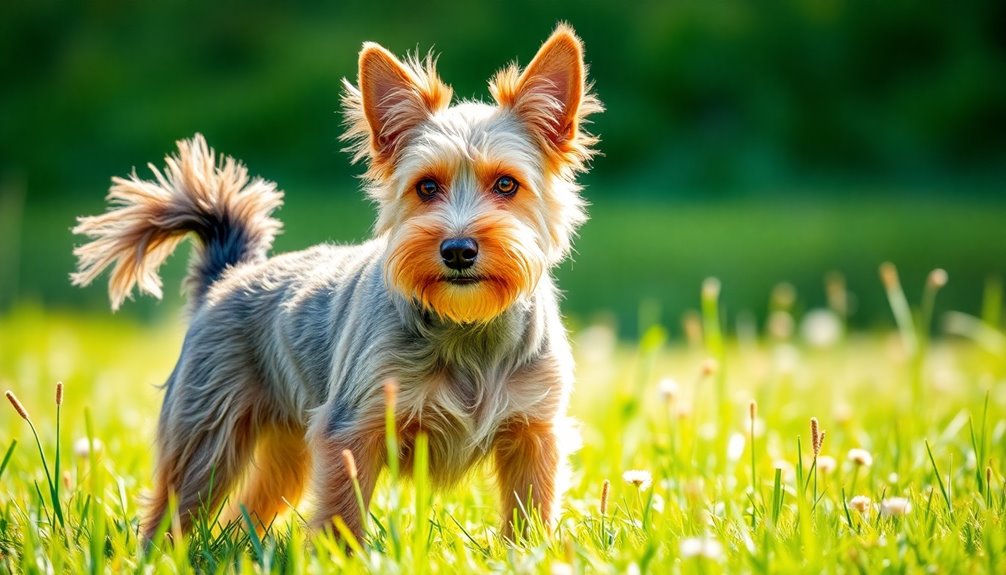
When you look at a Border Terrier, you'll notice their compact size, with males standing 13-16 inches tall and weighing between 11-16 pounds. Their distinctive double coat, which can come in various colors like red and grizzle-and-tan, adds to their unique charm. Plus, the facial beard and bushy eyebrows give them an expressive appearance that perfectly complements their sturdy build. This breed is known for its agility and strength, which makes them well-suited for burrowing and following hunts.
Size, weight, and coat details
How does the Border Terrier's size and coat contribute to its appeal as a small breed? These spirited companions stand between 11 to 16 inches tall, with males typically reaching 13 to 16 inches and females around 11 to 14 inches. Their slightly longer body gives them a well-proportioned, narrow build that exudes a sturdy yet playful presence.
Weighing in at 11.5 to 15.5 pounds, they maintain a balanced framework that complements their size. Weight influences health and activity levels, making it essential to monitor their diet and exercise.
The Border Terrier's coat is another standout feature. They've a double coat consisting of a short, dense undercoat and a harsh, wiry outer coat that lies close to the body. This weather- and dirt-resistant outer layer protects them from the elements, making them suitable for outdoor activities.
With no curls or waves, their coat requires regular brushing and biannual stripping to keep it in top shape.
Available in various colors, including red, grizzle and tan, blue and tan, and wheaten, the coat adds to the breed's charm.
Facial Beard and Bushy Eyebrows
The Border Terrier's facial features, characterized by a distinctive beard and bushy eyebrows, add to its unique charm and scruffy appeal. This breed boasts a broad, flat skull that supports a short, dark-colored muzzle and a black nose. The strong teeth, featuring a scissors bite, showcase their robust nature.
Their V-shaped ears fold forward, set closely against the cheeks, enhancing their expressive look. The ears are typically dark and have a slight lift at the outer edge, giving them a playful appearance.
What truly sets the Border Terrier apart are those wiry head furnishings. The beard, whiskers, and bushy eyebrows form a rugged yet endearing visage. These facial features may have longer, rough, wiry guard hairs, particularly prominent in the rough-coat variety. Regular grooming is essential to maintain their dense, wiry coat, ensuring that their unique appearance is kept in top condition.
To maintain that desirable texture and appearance, hand-stripping is often recommended. The medium-sized, dark hazel eyes sparkle with mischief, further emphasizing the breed's spirited personality.
With their expressive features and scruffy beards, Border Terriers aren't just companions; they're charming little characters that capture hearts.
Temperament and Personality
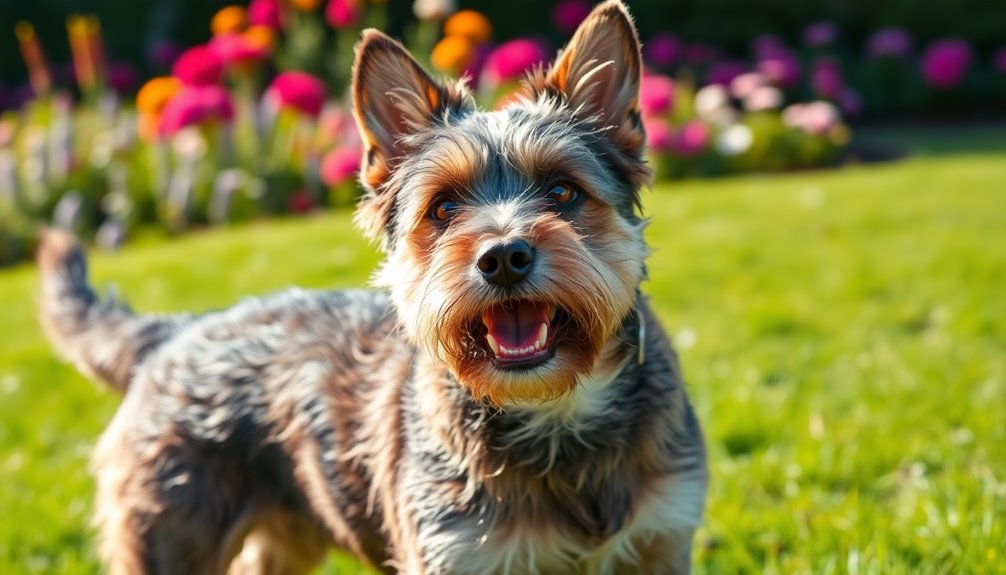
Border Terriers are known for their playful and curious nature, making them a delightful addition to any home.
Whether you have a family, live alone, or have other pets, their friendly demeanor allows them to fit in seamlessly.
You'll find that their energetic spirit and affectionate personality create a loving bond with everyone around them. Additionally, they are part of the Terrier group, recognized for hunting small game, which highlights their adventurous and spirited character.
Playful and Curious Nature
While they may be small in stature, Border Terriers are bursting with a playful and curious spirit that makes them delightful companions. Their high energy levels mean they thrive on activities like walking, running, and playing fetch. You'll find that they excel in dog sports, such as agility and obedience, showcasing their intelligence and eagerness to please.
Border Terriers possess a natural hunting instinct, making them perfect candidates for earthdog trials. Their alert gaze and keen curiosity often lead them to explore every nook and cranny, sometimes squeezing through narrow spaces to capture prey. Additionally, their intelligent and lively disposition makes them quick learners, allowing for a variety of training opportunities.
Without enough mental stimulation, they might dig or engage in mischievous behavior, so keeping them engaged is crucial. These little adventurers are also known as skilled escape artists due to their high energy and prey drive.
To keep your Border Terrier happy and healthy, provide regular exercise and interactive play, like puzzle toys and training exercises. They respond well to positive reinforcement, so using treats and praise during training can help you mold their spirited nature into well-behaved behavior.
With the right balance of play and training, your Border Terrier will thrive as an energetic, curious companion.
Suitability for families, individuals, or other pets
Finding the right companion for your family or lifestyle can be a rewarding experience, and Border Terriers stand out with their affectionate and adaptable nature.
These spirited dogs thrive on human interaction, forming strong bonds that make them perfect for families and individuals alike. Their loving temperament allows them to offer comfort and companionship, particularly to children, when properly trained and socialized. Additionally, it's important to consider the role of socialization in ensuring they develop into well-rounded pets.
Border Terriers adapt well to **
Health and Lifespan
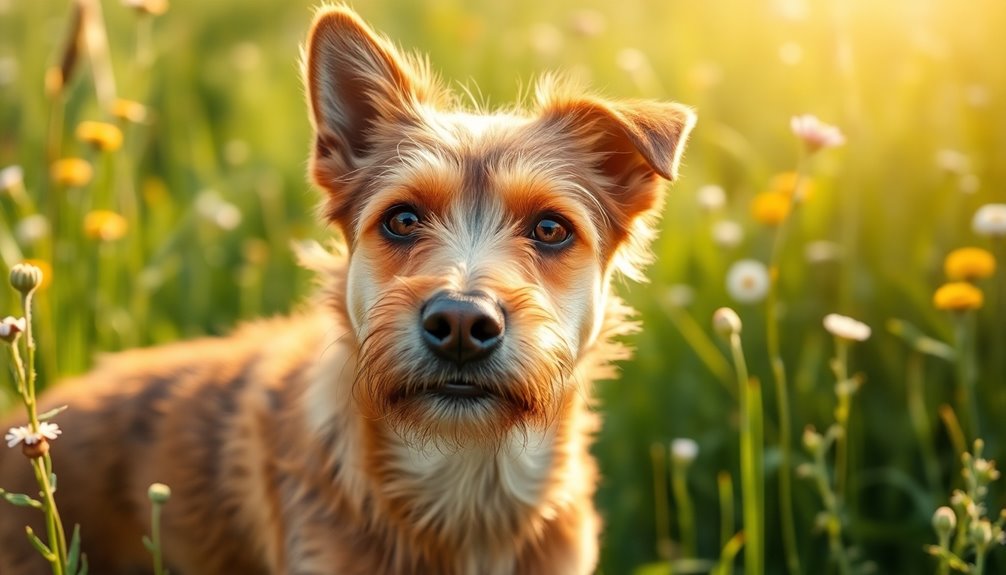
When it comes to your Border Terrier's health and lifespan, you can expect them to live around 12 to 15 years with proper care. However, be aware of common health concerns like hip dysplasia and obesity that can affect their quality of life. Regular veterinary check-ups can help mitigate these issues and ensure a longer average lifespan.
Typical lifespan of the breed
Border Terriers are known for their impressive lifespan, typically ranging from 12 to 15 years. With proper care, it's not uncommon for some Border Terriers to live up to 16 years or even longer. This longevity is relatively high when compared to many other breeds, as they generally outlive the average dog lifespan by about two years.
The lifespan of your Border Terrier can be influenced by several factors. Genetics is a significant determinant, but nutrition and a balanced diet play crucial roles too. Regular exercise keeps them fit and mentally stimulated, while access to veterinary care ensures preventive health measures are in place. Additionally, being aware of common health issues can help in identifying potential concerns early on.
A safe and comfortable living environment also contributes to their overall well-being.
As your Border Terrier ages, you might notice signs like decreased activity and changes in coat texture starting around 8 to 10 years. Regular vet check-ups become essential to address any emerging health issues.
Common health concerns or genetic predispositions
Addressing common health concerns is crucial for ensuring your Border Terrier lives a long, healthy life. This breed can be prone to several genetic issues. Orthopedic problems, such as hip dysplasia and luxating patella, can lead to lameness and difficulty standing. Keeping your dog at a healthy weight can help prevent early-onset arthritis. Additionally, regular exercise is important for maintaining their built-for-endurance physique, which supports joint health.
Border Terriers may also face eye and neurological conditions. Progressive retinal atrophy and juvenile cataracts are two serious eye disorders you should watch for. Additionally, some dogs may experience seizures or conditions like Canine Epileptoid Cramping Syndrome (CECS), which can cause muscle spasms.
Heart and endocrine health are significant concerns as well. Heart defects can affect your dog's overall well-being, and conditions like Cushing's Syndrome and hypothyroidism are common in older dogs. Regular blood screenings can help identify thyroid issues before they worsen.
Lastly, don't overlook skin and dental health. Periodontal disease affects a notable percentage of the breed, while allergic reactions can cause skin irritations. Establish a routine for dental care and monitor your dog for any signs of skin problems to keep them in tip-top shape.
Tips for maintaining health and wellness
Maintaining your Border Terrier's health and wellness is vital for a long, happy life. Start with a high-quality dry dog food, offering up to 1 3/8 cups daily, divided into two meals. Adjust the quantity based on your dog's specific needs and ensure fresh water is always available. Regularly checking and cleaning their food and water bowls can help maintain hygiene and prevent contamination.
Avoid giving people food to prevent weight issues; you should be able to feel their ribs but not see them.
Exercise is crucial—aim for at least an hour each day, combining walks, playtime, and training sessions. Activities like agility and flyball not only keep your dog fit but also mentally stimulated. High energy levels mean they will thrive on interactive play and regular exercise.
Always check their paws for injuries after runs, especially in hot weather.
Grooming helps maintain hygiene. Brush your Terrier's coat a couple of times a week, and clean their ears weekly. Regular maintenance of their grooming tools is also recommended to ensure effectiveness.
Brush their teeth at least three times weekly to prevent dental issues.
Create a safe living environment, supervise your dog, and ensure they've a securely fenced yard.
Regular veterinary check-ups and vaccinations are essential, and consider pet health insurance to cover unexpected medical expenses.
Your efforts will lead to a healthier, happier Border Terrier.
Care Requirements
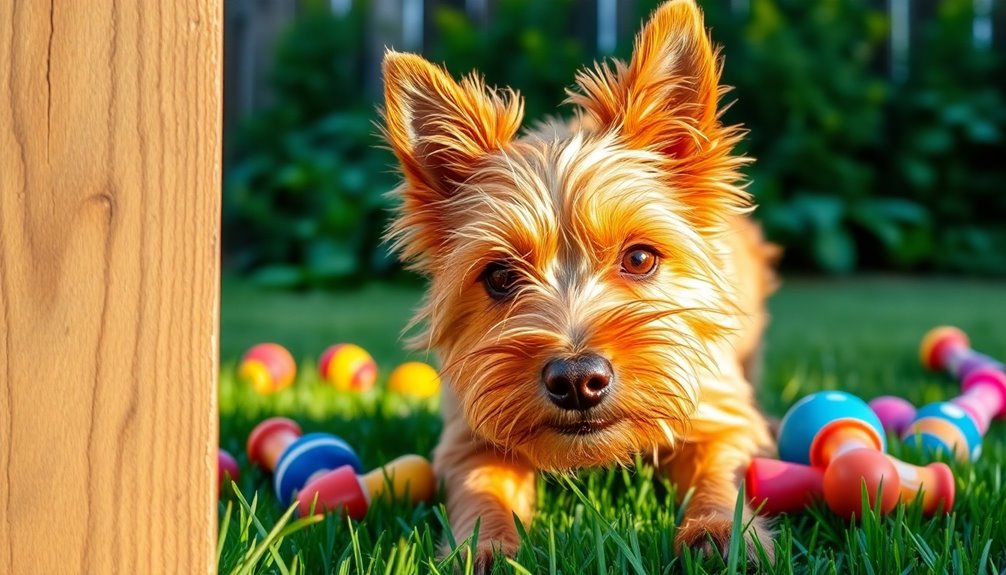
Taking care of your Border Terrier involves meeting their exercise needs, providing a balanced diet, and maintaining their grooming routine.
You'll need to commit to regular hand-stripping to keep their coat healthy, alongside daily walks and playtime to match their high energy levels. Border Terriers require substantial daily exercise to maintain happiness and prevent destructive behavior, making it essential to incorporate various activities into their routine.
Feeding them the right amount of nutritious food is crucial for their overall well-being, so be sure to follow recommended guidelines.
Regular Hand-Stripping Required
Hand stripping is essential for keeping your Border Terrier's coat in top condition. This breed has a unique double coat, featuring a harsh top coat and a soft undercoat. Regular hand stripping preserves the coat's texture and color while removing dead and loose hairs, preventing it from becoming soft and less waterproof.
To hand strip effectively, use your fingers and thumb to pull the dead hairs directly from the root, ensuring you avoid breaking them. Employ a comb and scissors for any necessary trimming, and optional chalk powder can help you grip the hair better.
Focus on the entire body, including the legs, tail, and head, paying special attention to sensitive areas like the face and ears. Remember that regular brushing is crucial in managing loose fur and maintaining the coat's health.
You should hand strip your Border Terrier every 6-8 weeks or at least twice a year. Daily brushing will help manage loose fur and maintain the coat's health.
Avoid bathing unless necessary, as it can strip the coat's natural oils. Lastly, keep up with regular nail clipping to prevent overgrowth and discomfort. Taking these steps will ensure your furry friend stays looking sharp and feeling great!
Exercise requirements and energy levels
Exercise is vital for keeping your Border Terrier healthy and happy. They need at least an hour of exercise each day, so splitting this into two 30-minute walks is a great approach.
Incorporate some off-lead time in a secure area where they can safely explore, as their high prey drive requires caution. Additionally, it's important to monitor their activity level as they can be prone to obesity if not exercised regularly.
In addition to walks, your Border Terrier thrives on playtime and training sessions. Engage them with games like fetch or frisbee, and consider taking them on family hikes for a fun way to burn off energy.
Canine sports such as flyball or agility courses can also offer excellent mental and physical stimulation.
With their high energy levels, it's essential to keep them active. They adapt well to various environments but need regular exercise to stay content.
Your furry friend will love exploring new places, especially those with livestock or water activities, as some are natural swimmers.
Feeding tips and diet recommendations
Feeding your Border Terrier the right diet is crucial for their overall health and well-being. Start with high-quality protein sources like beef, chicken, or fish, which provide the essential nutrients they need. Include healthy fats with omega-3s to support joint health and reduce inflammation. Additionally, ensure that the food you choose maintains healthy weight to prevent obesity, which is a common concern for this breed.
Small amounts of carbohydrates from vegetables and berries can offer fiber and antioxidants, while natural vitamins and minerals from bone and plant sources round out their diet.
For adults, feed two meals a day; puppies need 3-5 small meals to prevent hypoglycemia. Monitor portion sizes carefully to maintain a healthy weight, and keep treats to no more than 10% of their daily calories. Choose balanced dog food that meets AAFCO standards, or consider fresh or raw diets for better digestion and health benefits.
Be mindful of their tendency to gain weight—keep them lean. If your Border Terrier has a sensitive stomach or allergies, opt for diets with known ingredients.
Lastly, consult your vet before adding supplements or designing homemade diets to ensure they meet nutritional needs.
Training and Socialization
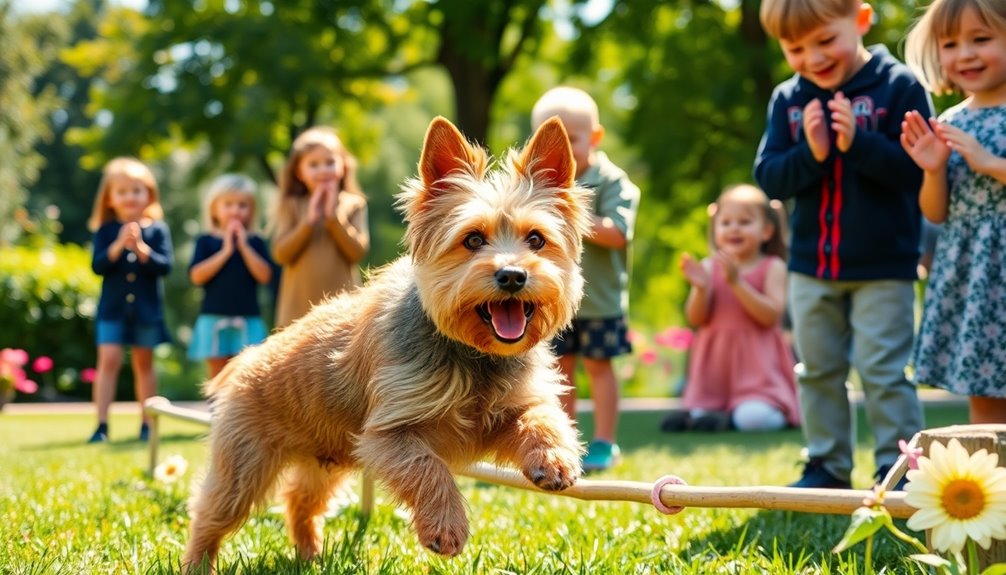
When training your Border Terrier, you'll find they're moderately responsive to commands, so be patient and consistent. Gradually introducing them to new friends helps build their confidence and social skills, making outings more enjoyable. It's important to remember that these dogs have a high energy level, which can contribute to their need for regular exercise and mental stimulation. Watch for leash reactivity towards other dogs, as this can be managed with proper training and socialization techniques.
Moderately Responsive to Commands
Border Terriers are moderately responsive to commands, which means they can be trained effectively but may occasionally display an independent streak. To train your Border Terrier successfully, use positive reinforcement techniques. Reward desired behaviors with treats, praise, or toys right after they happen to help your dog understand what you want. Consistent training is required for long-term success, so ensure everyone in your household uses the same training methods and rewards to avoid confusion.
Establishing yourself as the leader of the pack is vital. Set clear rules and boundaries, and always enforce them consistently. For example, teach your dog to respect exits by rewarding them for waiting before proceeding out of doors or gates.
Start with basic commands like 'sit,' 'stay,' and 'come,' and gradually introduce more complex commands once they've mastered the basics. Keep their training interesting by varying rewards and incorporating interactive play.
Don't forget to provide mental stimulation through puzzle toys to prevent boredom and mischievous behavior.
With patience and persistence, you can overcome their independent traits and enjoy a well-trained, responsive companion.
Gradual Introductions to New Friends
Introducing your Border Terrier to new friends can be a rewarding experience, but it requires a thoughtful approach. Start socialization as early as possible, ideally during the puppy stage. Involve friends and family to help your dog get used to various people, including those in different outfits or carrying items like bags and umbrellas.
Begin with small interactions in neutral environments to reduce anxiety and territorial behaviors. Gradually increase the number of people and the complexity of the surroundings. Use positive reinforcement—reward your dog with treats, praise, or attention for good behavior during these introductions. Additionally, early socialization with diverse people can foster your dog's confidence and adjustment to new situations. This process can be enhanced by understanding the importance of emotional alignment in fostering a positive atmosphere during introductions.
Monitor your dog's body language to gauge their comfort level, and be prepared to intervene if they become anxious or overstimulated. It's essential to take things at a comfortable pace for your Border Terrier.
Avoid crowded areas initially, focusing on smaller groups until your dog feels more confident.
Leash Reactivity Towards Other Dogs
Leash reactivity towards other dogs often occurs, making walks a challenging experience for both you and your Border Terrier. Understanding your dog's triggers is vital. These could be other dogs, unfamiliar people, or even specific contexts like being on a leash. Observing your dog in various situations will help identify what sets off their reactions. Ensuring you recognize the signs of increasing reactivity can help you intervene before the situation escalates.
To address the issue, set up training sessions in safe, controlled environments, like parks. Start by using calm dogs and maintain a safe distance to keep your dog relaxed. Positive reinforcement is key; use treats, toys, and praise to create positive associations with the triggers.
Using a head halter or harness can help control your dog's movements and reduce lunging. Remember to keep the leash loose to minimize stress.
As your dog becomes more comfortable, gradually reduce the distance to the triggers while rewarding calm behavior.
If the reactivity persists, consider seeking help from a professional dog trainer or veterinary behaviorist. With patience and consistent training, you can help your Border Terrier feel more at ease on walks, creating a more enjoyable experience for both of you.
Ideal Living Environment
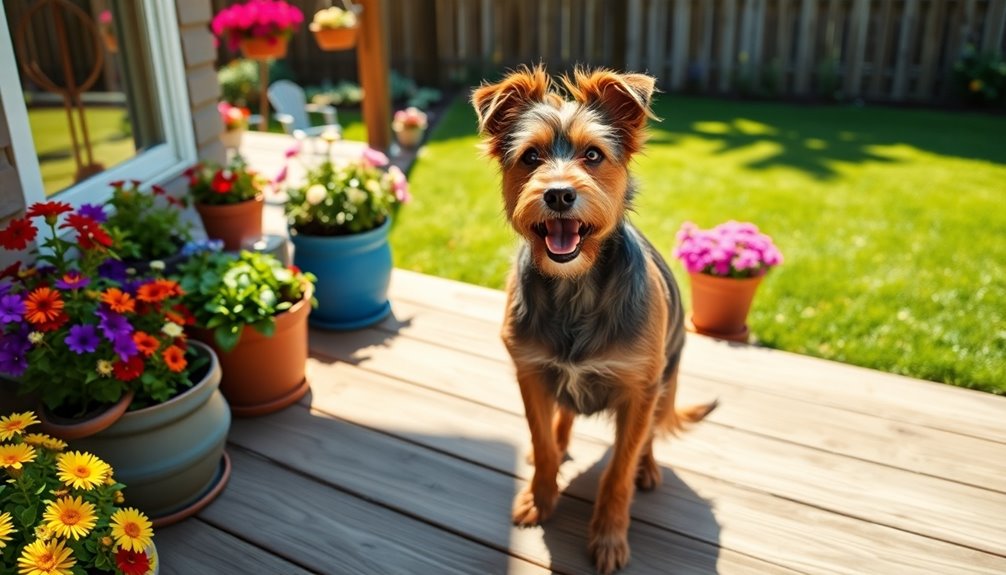
When considering your living environment for a Border Terrier, secure fencing is essential to keep them safe and prevent escape. They thrive best in temperate climates, which help them stay comfortable during outdoor activities. A well-fenced yard not only protects your dog but also provides a space for them to play and explore safely. Regular exercise is crucial for maintaining their overall health, ensuring they remain happy and well-adjusted.
House With Secure Fencing
Secure fencing is essential for creating an ideal living environment for your Border Terrier. These spirited companions are instinctive vermin hunters, which means they can't be trusted off-leash or in unfenced areas. Their strong prey drive often leads them to chase rabbits, squirrels, or other small animals, putting them at risk of getting lost or injured.
A secure fence not only contains your Border Terrier but also minimizes constant barking and protects against attacks from other dogs or theft. Understanding their territorial behavior can guide you in selecting the most appropriate fencing options.
For effective fencing, consider solid wood or privacy fences, as they provide durability without gaps. Chain-link fences with privacy slats are also a good choice. If you opt for invisible electric fences, remember that their effectiveness depends on proper training. It's crucial to ensure that the fence extends below ground level to prevent digging escapes.
Regular inspection and maintenance of your fence are vital to keep it intact. Additional features like coyote rollers can enhance security.
Temperate Climate Preference
A temperate climate provides an ideal living environment for Border Terriers, allowing them to thrive thanks to their adaptability. These spirited companions don't require extreme temperatures to feel comfortable, making them perfect for areas with moderate weather.
In a temperate setting, you can easily meet their exercise needs through daily walks and play sessions, essential for their physical and mental health. Additionally, providing a high-quality diet is crucial for their overall well-being and energy levels.
Border Terriers can comfortably live in both urban and rural environments. In urban areas, just ensure they get regular outdoor time, even if you're in a smaller space.
Meanwhile, rural settings offer ample room for exploration, aligning with their natural instincts. Regardless of location, engaging them in mental enrichment activities like canine sports keeps boredom at bay.
They adapt well to seasonal changes, needing shorter walks in colder months and early or late outings during hotter seasons to avoid heat stress.
Regular grooming remains vital throughout the year to keep them healthy and looking good. Overall, as long as you provide consistent exercise and stimulation, your Border Terrier will thrive in a temperate climate.
Energetic Diggers and Burrowers
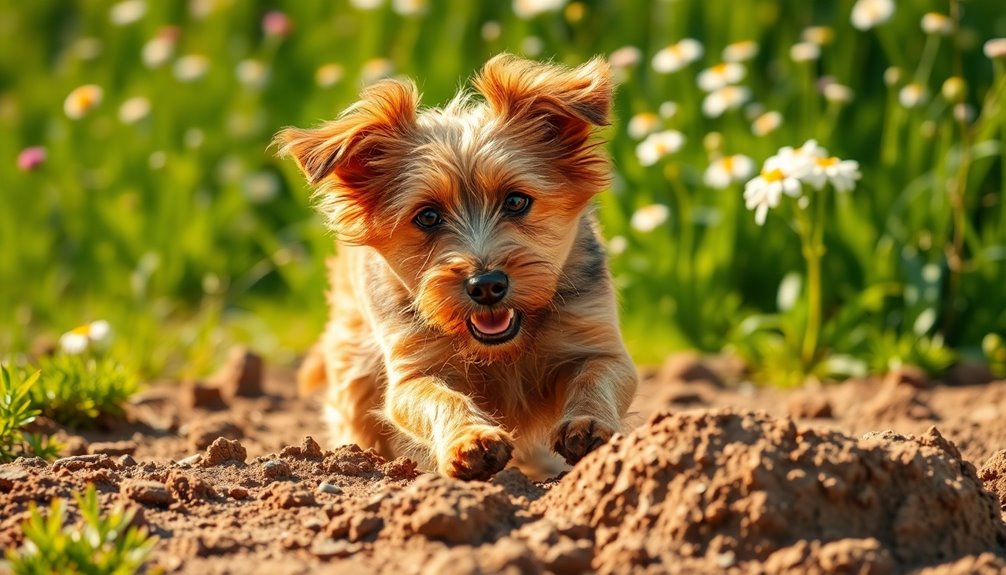
If you've got a Border Terrier, you're likely aware of their exceptional ratting abilities, which showcase their natural digging instincts. These dogs were bred to hunt and retrieve prey, and their impressive skills are highlighted in stories like 'The Incredible Journey.' Understanding this instinct can help you manage their energetic digging and keep them engaged. Additionally, their genetics can significantly influence their digging behavior, making it essential to provide them with appropriate outlets for this natural tendency.
Exceptional Ratting Abilities
Border Terriers truly shine when it comes to their exceptional ratting abilities, thanks to their energetic digging and burrowing instincts. Their compact and sturdy build makes them well-suited for this task, allowing them to navigate tight spaces with ease.
With a wiry, dense double coat, they stay protected while working underground, showcasing their natural affinity for hunting prey beneath the surface.
These terriers originated as hunters of foxes and other small game, and their determination and tenacity are crucial in pursuing quarry. Their prey drive fuels their relentless efforts, making them effective ratters. In fact, the tenacity of terriers is often a key trait that enhances their success in ratting.
You'll find that their high energy levels require regular exercise, so involving them in activities like walking, running, or playing fetch will keep them engaged.
Border Terriers are agile and quick, so they excel in earthdog trials and other dog sports. However, it's essential to provide mental stimulation to prevent boredom, as they can become stubborn if not challenged.
With proper training and socialization, these intelligent dogs can form strong bonds with your family and get along well with other pets, making them exceptional companions both in and out of the field.
Featured in 'The Incredible Journey
The incredible journey of a Border Terrier often highlights their innate talents as energetic diggers and burrowers. Bred to follow prey into underground tunnels, these spirited companions possess strong instincts that make them natural hunters. Their ancestry with Border Foxhounds involves controlling hill foxes, which contributes to their tendency to dig. You may notice your Border Terrier digging after small animals like moles or mice, or even creating cozy spots to rest during extreme weather.
However, this digging behavior can lead to escape attempts if your yard isn't properly secured. To manage this, supervise your pup and provide designated digging areas as an outlet for their instincts. Anxiety-driven digging can indicate distress or fear of solitude, so it's essential to monitor their behavior closely.
Engage them with interactive toys or puzzle games to keep boredom at bay. Regular exercise is crucial, so consider activities like agility training or earthdog trials to stimulate their mind and body.
With proper training and management, you can channel their digging behaviors positively. Remember to create a safe and enriching environment that allows your Border Terrier to thrive while satisfying their energetic digging and burrowing needs.
Active Lifestyle Compatibility
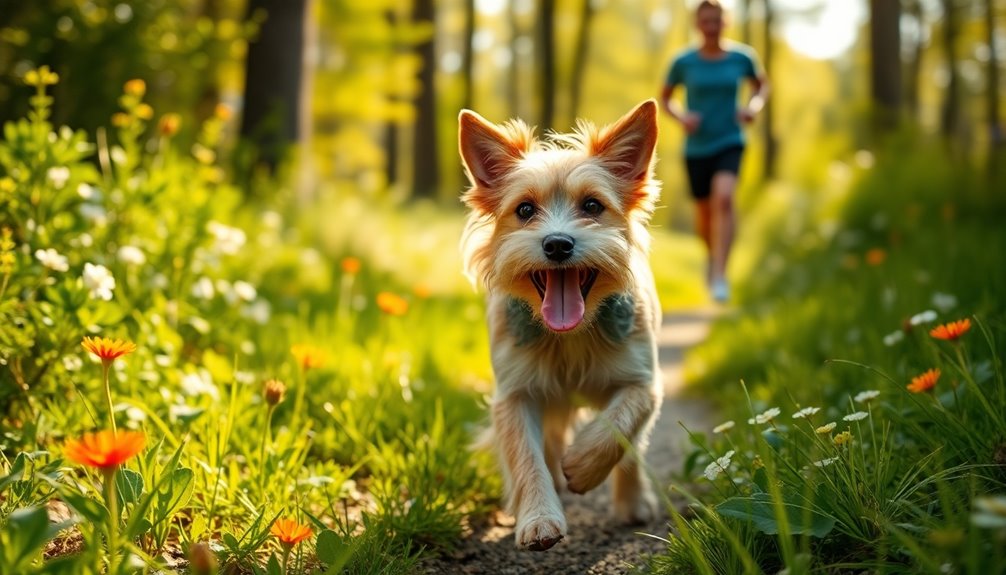
Border Terriers are perfect companions for active households, as they thrive on daily exercise and mental challenges. You'll find that their energetic nature aligns well with an outdoor lifestyle, making them great for walks, runs, and engaging dog sports. Their affectionate nature allows them to bond deeply with family members, enhancing the overall experience of companionship. Just keep in mind their grooming needs, as regular brushing is essential to maintain their coat and overall health.
Versatile for Active Households
For active households, Border Terriers are an excellent choice, bringing energy and enthusiasm to family life. Their high energy levels require at least one hour of exercise daily, which you can split into multiple walks, playtime, and even dog sports like agility. These spirited companions thrive on activities such as running, fetching, and exploring, making them perfect for families on the go.
Border Terriers are family-friendly and display patience with children, ensuring everyone has fun together. However, they need early socialization to get along with other pets. Their adaptability means they fit well in various living environments, whether you're in a bustling city apartment or a spacious country home. This breed is also known for its minimal barking**, alerting owners to visitors without being overly vocal.
To keep them happy, include them in all family activities, as they love companionship. They also require mental stimulation through interactive play and training exercises to prevent boredom and mischief. With their intelligence and eagerness to please, you can easily train them using positive reinforcement methods. Just remember, these little hunters have strong instincts, so providing secure off-lead areas is essential.
All in all, a Border Terrier is a fantastic addition to any active household!
Grooming Needs and Frequency
Grooming a Border Terrier is essential to maintain its unique coat and ensure your furry friend stays healthy and comfortable. Their hard, wiry coat requires a specific maintenance routine to keep it in top shape. You'll need to brush your dog weekly to prevent matting and tangling while removing loose hairs. Hand stripping is also important; it helps maintain the coat's texture and stimulates new hair growth. Aim for professional grooming every few months to keep the coat looking its best.
For sensitive areas like the cheeks, throat, and sanitary regions, thinning scissors or clippers are recommended. Avoid clipping the entire coat, as this can soften it. Regular grooming not only enhances your dog's appearance but also helps to identify potential health issues early on. When bathing, use mild, hypoallergenic shampoos as needed and allow 24 hours post-stripping for the hair follicles to close before washing.
Regularly check and clean your dog's ears and trim their nails. Tools like an undercoat rake, slicker brush, and rubber curry can make grooming easier. With consistent care, you'll ensure your Border Terrier remains not only stylish but also comfortable, allowing them to thrive in your active lifestyle.
Frequently Asked Questions
How Do Border Terriers Interact With Other Dog Breeds?
When Border Terriers interact with other dog breeds, it's essential to introduce them properly and early.
They generally get along well if introduced to dogs of the opposite sex, but socialization is key.
During walks, be prepared for unpredictable behavior, especially if they've had negative encounters before.
With consistent training and clear boundaries, you can manage their interactions effectively, ensuring a harmonious environment with other dogs in your household.
What Are Common Behavioral Issues in Border Terriers?
Common behavioral issues in Border Terriers include aggression towards other dogs while on a lead, barking defensively, and inconsistent reactions based on the situation.
Their independent nature can lead to stubbornness, mischievous behavior, and a strong prey drive. High energy levels demand regular exercise and mental stimulation to prevent destructive actions.
Additionally, challenges in house training and the need for early socialization are crucial to ensuring they develop good manners and appropriate behaviors.
Can Border Terriers Live in Apartments?
Yes, Border Terriers can live in apartments! Their small to medium size makes them well-suited for smaller spaces.
As long as you provide them with enough exercise—around an hour each day—and mental stimulation, they'll be happy. They're relatively quiet, which is great for apartment living.
Just make sure you take them for regular walks and playtime to keep them engaged and healthy, preventing any potential destructive behaviors.
How Do I Groom My Border Terrier Properly?
To groom your Border Terrier properly, brush them daily to remove dead hair and dirt.
Regularly hand strip their coat to maintain its texture, ideally twice a year.
Only bathe them when absolutely necessary, using a damp cloth for most cleaning.
Don't forget to clip their nails and check sensitive areas for hygiene.
Use the right tools, like a slicker brush and stripping tool, to ensure their coat stays healthy and vibrant.
What Foods Are Best for Border Terriers?
To keep your Border Terrier healthy, focus on high-quality protein for muscle maintenance and essential fatty acids like Omega-3 for joint support.
Include small amounts of carbohydrates from vegetables and berries for fiber and antioxidants.
Ensure hydration with fresh water and moisture-rich foods.
Consider adding glucosamine and chondroitin for joint health.
Tailor their diet to life stages, avoiding human foods to prevent weight gain and promote overall wellness.
Conclusion
In conclusion, border terriers make fantastic companions for those who appreciate their spirited nature and energetic lifestyle. With a rich history and endearing personality, these dogs thrive in active environments where they can dig, burrow, and play. Proper training and socialization are key to helping them shine. If you're ready to embrace the joy of having a border terrier, you'll find a loyal friend who brings endless love and fun into your life.

